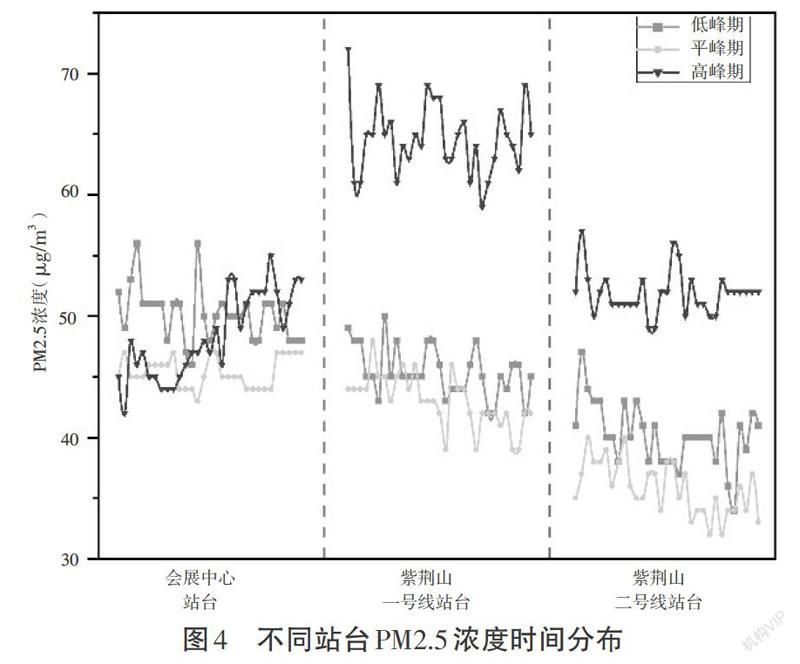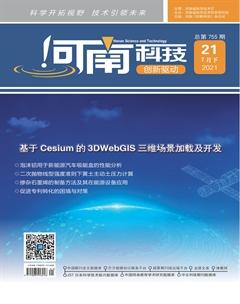过渡季郑州地铁站区细粒污染物时空分布特性研究
熊银 马雨欣 赵文娴 张志辉 李瑞鑫



摘 要:近年来随着我国城市化进程的逐步提速,城市地下轨道交通获得长足发展。郑州作为国家中心城市,地铁建设已成为城市发展中最重要的民生工程与保障工程之一。为探明郑州地铁站区室内细粒污染物浓度及分布规律,本文以郑州地铁一号线为研究对象,采用现场实测的方法分析典型地铁站内PM2.5的时空分布状态及规律。研究结果显示,郑州地铁浅埋站台细粒污染物更易受到室外空气质量影响,在竖向由浅入深的埋深方向上则呈现出PM2.5浓度先高后低的分布特征。人流密度与细粒污染物的空间分布呈高度相关,部分站台高峰期室内PM2.5浓度接近二级标准的阈值。
关键词:地铁站;PM2.5;空气品质;实测;时空分布
中图分类号:U231.5;X513 文献标识码:A 文章编号:1003-5168(2021)21-0080-03
Time-Space Distribution Characteristics of Fine Particulate Matter in Zhengzhou Metro Station During Transition Season
XIONG Yin MA Yuxin ZHAO Wenxian ZHANG Zhihui LI Ruixin
(School of Civil Engineering, Zhengzhou University, Zhengzhou Henan 450001)
Abstract: In recent years, with the gradual acceleration of urbanization in China, urban underground rail transit has achieved considerable development. Zhengzhou as a national central city, subway construction has become one of the most important people's livelihood projects and security projects in urban development. In order to find out the con- centration and distribution of indoor fine particles in Zhengzhou subway station area, this paper takes Zhengzhou Metro Line 1 as the research object, and analyzes the temporal and spatial distribution of PM2.5 in typical subway stations by field measurement. The results show that the fine-grained pollutants in Zhengzhou subway shallow platform are more susceptible to outdoor air quality. In the vertical direction from shallow to deep, the distribution of PM2.5 concentration first increases and then decreases. The human flow density was highly correlated with the spatial distribution of fine-grained pollutants, and the indoor PM2.5 concentration was close to the threshold level-2 during the peak period of some stations.
Keywords: metro station; PM2.5; indoor air quality; field measurement; time-space distribution
隨着我国城市化进程的提速,土地资源紧缺与需求量不断增加之间的矛盾推动了城市地下空间的快速开发与利用。在此契机下,地铁凭借着其便捷、准时、快速等优点成为人们出行的首选。郑州作为国家中心城市和中原人口聚集地,目前已完成规划地铁线路21条,开通运营地铁线路7条,全长203 km,建设有车站153座。据郑州轨道交通数据,客流量最大的1号线2020年日均客流量已达42.41万乘次,并于2020年12月31日创下单日客运量最高记录221.76万人次。与此同时,不断攀升的客流量、封闭的地下空间以及长期运行的通风系统等因素,使得地铁站内空气品质问题日渐突出,空气污染影响甚至威胁到乘客的健康。
现有研究表明,大气颗粒物暴露与肺癌和心血管等疾病存在密切关系[1-2],而地铁车站室内分布的PM2.5是造成乘客污染暴露的重要元凶。樊越胜等研究发现,西安市地铁2号线站厅、站台、车厢空气中的PM2.5浓度超标率分别为30.6%、75.4%、29.5%[3];Adams等研究得出伦敦地铁系统空气中PM2.5浓度比地面PM2.5浓度高3~8倍[4]。
为探明郑州地铁站区室内空气污染暴露水平,本文以地铁1号线紫荆山站与会展中心站为研究对象,选择典型时段开展连续实测,围绕定性与定量相结合的分析方法进行讨论,旨在为郑州地铁站区污染物控制方案的制定与乘客乘坐地铁出行模式的选择提供理论参考。

